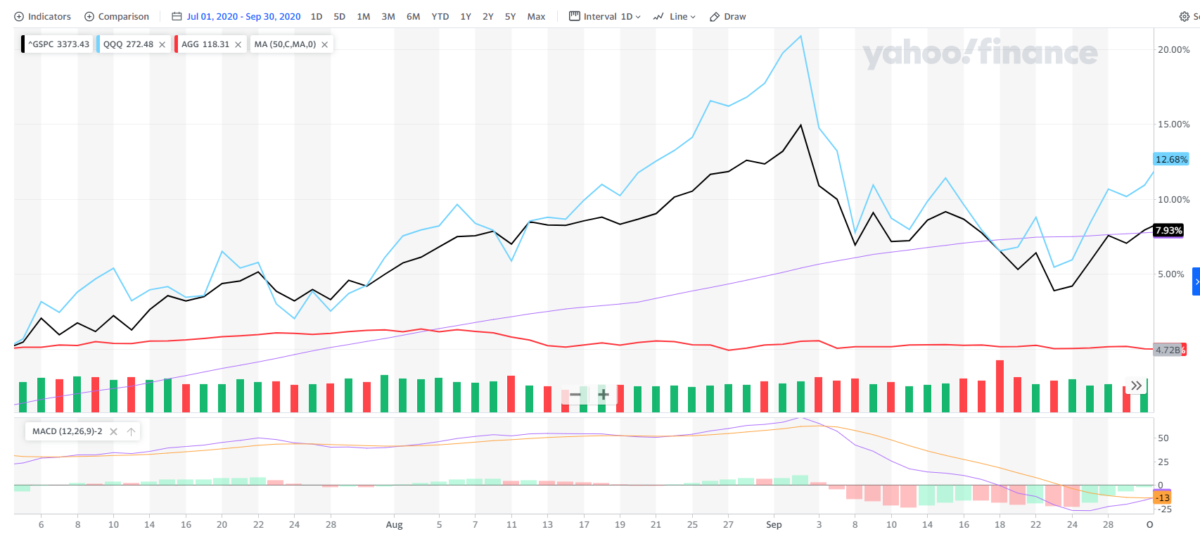The Third Quarter 2020 saw a continuation of improvement in the financial markets and the economy. Throughout the quarter, the S&P 500 turned positive year-to-date, made a new all-time high, declined back to the flat line year-to-date, and ultimately gained close to 9%. The bond market was virtually flat.
After a strong July and August, the broad U.S. equity market (as defined by the S&P 500) gave back some gains during the September slump, closing down close to 4% after a brief correction in the beginning of the month. Large cap technology took an even bigger hit, declining 12% from its peak to trough before settling the month with a loss of less than 6%. In our opinion, August went too far too fast, so a brief pullback should be viewed as normal, healthy, and constructive. Overall, for the quarter, our managed accounts gained 5-9%, depending on the risk profile – handily outperforming their respective benchmark, and each sitting with gains around 3% net of fees year-to-date.
PORTFOLIO COMPOSITION:
While this helped reduce some of the drawdown that occurred in September, it has not been to the expense of keeping up with an overall higher trending market.
Overall, we are taking a more balanced, barbell approach to navigating this market, still with a significant U.S. and large cap bias. There has not yet been a durable and sustainable enough shift from growth to value in the overall market for us to continue to reduce growth/tech in favor of value. For the quarter, the value index, as defined by RPV, gained 3.5% while the growth index, as defined by RPG, gained 10%. OUSA fell closer to the higher end of that range, closely tracking the S&P with a return of 8.5%. Sector exposure of OUSA was one reason we opted for this fund, with quality dividend growth names in the technology, healthcare and consumer cyclical names being well represented.
We continue to shy away from more economically sensitive areas of the market (energy/XLE, real estate/XLRE, financials/XLF), as well as situationally risker areas such as small caps (IWM) and international (EFA), each of which underperformed the broad market during the quarter. Out of that group, energy performed the worst, down over 20%. Small caps (IWM) are still down 8% on the year.
Even with the September slump, technology and mega cap still outperformed the broad market, with QQQ gaining over 12% for the quarter, and the S&P top 50 (XLG) gaining 9.5%, a slight lead over the S&P 500. Further adding to our relative strength concentration, our decision to continue to avoid international exposure added to our results, with EFA gaining only 4% for the quarter and still down 8% on the year. Collectively, our overweight in the stronger areas of the market, aided our outperforming our benchmarks, which benchmarks contain small caps and foreign stocks.
ECONOMY:
of the extended unemployment and PPP benefits, the market continues to look forward and grind higher. We believe what caused the September slump was a combination of an uptick in COVID-19 cases (largely as a result of college students returning to campus), concerns about an unorderly election in November, speculation over Congress providing another round of stimulus to families and small businesses, and whether current lofty valuations in technology are justified and sustainable. It our belief that nothing materially deteriorated fundamentally in September but taking pause and shaking out some weak hands is usually constructive pricing action that enables the market to make another new high.
During the Fed’s most recent meeting, Chairman Powell stated that they intend to keep interest rates at or near zero for the foreseeable future. They also indicated a willingness to allow inflation to exceed their 2% target for some time before considering raising rates. This should continue to help prop up the economy and stock market through reduced borrowing costs and encourage greater risk taking by market participants, particularly those seeking yield, given the dividend yield on the S&P 500 is significantly higher than the yield on treasuries. Hotter inflation should also encourage higher equity allocations to help investors keep pace with a rising cost of goods and services. The T.I.N.A (there is no alternative) factor should also continue to keep the market elevated, as demand for yield still cannot be satisfied from bonds in this low rate environment. Bottom line is that we feel there are still tailwinds that can support the market at current, and higher, levels.
TECHNICALS:

LOOKING AHEAD:
